CHAPTER 2
SYMPTOMS AND SIGNS
How to Take Your Complete
Health Inventory
The secret of health for both mind and body is not to mourn for the past, nor to worry about the future, but to live the present moment wisely and earnestly.
—THE BUDDHA
IF YOUR GOAL IS OPTIMAL HEALTH AND WELL-BEING, then you must start with an understanding of the present state of your health. A physical examination with your medical doctor is a good place to begin. However, since that is often a once-a-year visit, what you do to keep track of your health the rest of the year is just as important, if not more so.
Before you start anything, whether a project, a trip, or an exercise program, you need a vision, a big-picture idea of the outcome and how it fits into your life’s mission. If it doesn’t fit, then you must change course. By taking an inventory of your life, you will become aware of where you are in the journey of life. Too often people allow the currents of life to sweep them away—far from where they intended to go. Or they become complacent and refuse to remove obstacles to their life goals.
Self-awareness is essential for reaching your full health and wellness potential. Awareness means attending to and becoming mindful of all things, within and outside of yourself. Are you aware of your body temperature, breathing pattern, and physical sensations at any given moment? Probably not! Most of us are not. These are unconscious functions that we take for granted. You are breathing, talking, moving, thinking, and sensing during waking hours. It’s precisely how you breathe, talk, move, think, and sense that define the quality of your life. Becoming conscious of such important acts is critical to living optimally. This will require a little practice, but once you become conscious of these things it is effortless.
Becoming fully aware can be difficult in the midst of endless distractions, but awareness is an ability that every child is born with. Observe how a baby responds to every sound and light stimulus, every touch, the emotions of other people, and the changes inside his or her body: hunger, discomfort, hot, cold, and energy. The baby will cry to communicate needs and dislikes and laugh when happy and content. As that child becomes an adult, some innate awareness is lost and it will be replaced by social etiquette, intellectual learning, and worries about how to fit in. The results of this external conditioning become apparent as we grow older, causing innate awareness to give way to busy mental chatter. However, with practice, you can restore awareness and become fully conscious of your life.
CRITICAL QUESTIONS FOR SELF-ASSESSMENT
I SUGGEST TO MY PATIENTS AND STUDENTS—and to you—that the first thing to do upon waking is take a look in the mirror and ask, “Who am I and how do I want to be today?” This might sound tedious. Why would you want to know who you are before you start your day? If you’re not aware of the direction of your life, the world’s currents will carry you along and you may end up where you do not want to be. It’s easy to keep behaving in a certain way because that’s what you’ve been doing for a long time—but to expect a different outcome without a change in behavior is insane. By being conscious of what needs to change, and knowing how to implement that change, you can move toward fulfilling your vision.
The answer to your inner query is very personal, and, of course, it varies from person to person. Here are my daily reflections, which I’ve refined over time, but which have remained fairly constant over the last twenty years. Each time I ask myself the question I choose my reply consciously.
Q: Who am I?
A: I am a child of the Universal Divine and Mother Earth, a person of love, compassion, and integrity, an instrument of constructive change and a student of Truth.
Q: How do I want to be today?
A: Today I want to be connected in spirit to that of the Universal Divine. I want to be clear in my mind so that I make the correct decisions. I want to be healthy and energized in all that I do. I want to be filled with love in my heart toward my fellow brothers and sisters, to be a good steward of Mother Earth, and I want to be the best that I can be in expressing the essence of my being.
A SIMPLE AWARENESS EXERCISE
HERE IS A SIMPLE MEDITATIVE EXERCISE to help you sharpen your awareness. Close your eyes and listen intently to your breath. Is your breathing fast or slow, shallow or deep, rhythmic or irregular? Do you feel your lungs and abdomen expand and contract as you breathe? Does the air feel dry or moist? Is there congestion in your nose, throat, or chest? Do you hear rattling of mucus as you take every breath in? All you are doing is observing your breath, without judgment or correction. Once you are conscious of it, move on to the next segment.
Expand that awareness to your entire body. Keep your eyes closed. Sense and feel every part of your body, starting from your head, and down to your toes. Is there discomfort or pain anywhere? How about pressure and tightness? Can you feel your digestion? Is there movement within your abdomen? Do you feel weakness anywhere? Does your posture feel aligned? Can you feel your heart pounding or pulsating? Are you aware of any tingling, numbness, or burning? Do your hands and feet feel cold? Can you feel the flow of energy and blood throughout your body? Observe and make notes, but do not form an opinion. Once you accomplish the survey of your body, move on to the final segment of the practice.
Expand your awareness to your surroundings. Keep your eyes closed, even when trying to sense the lighting. What is the temperature on your skin and in the environment? What about lighting—does it seem cloudy or sunny outside? What do you hear? Are there subtle sounds beyond those generated by people and animals? Can you make out any smell? Do you feel the airflow or draft? Where is it coming from? What does the clothing on your skin feel like? Can your skin freely breathe? Do you detect electromagnetic fields from appliances and other subtle energies in your immediate environs?
Conclude your awareness meditation by writing down what you observed. With regular practice this exercise should take no more than five minutes. It will help you sharpen your sense of perception, which is vital for any successful wellness-maintenance and self-healing program. Next we’ll use our five senses to learn about ourselves and what symptoms and signs may mean in terms of our health. In some situations you’ll be alerted by visual cues, and you’ll be able to take measures immediately. But the value of self-inspection lies in detecting subtle imbalances and dealing with them preventively through diet, lifestyle, and other restorative principles. Taking care of things while they’re small will help you avoid big problems.
VISUAL INSPECTION
Your body speaks a unique language to communicate the imbalances within it. Over the past 5,000 years Chinese medicine has mastered the art and science of reading the body’s language. A picture tells a thousand words, and your face, tongue, ears, hands, and feet reflect many processes within your internal systems.
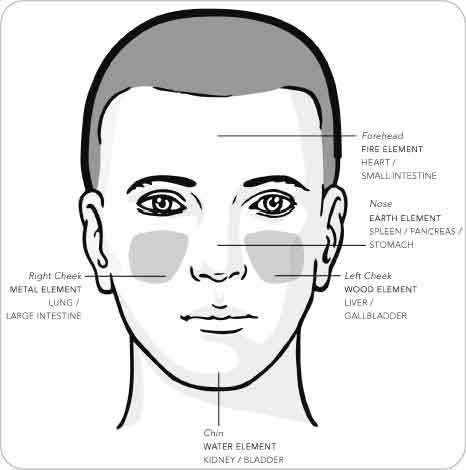
THE WHOLE FACE WITH ELEMENT ZONES
The five-element network is reflected in zones on the face. The forehead corresponds to the fire element, the nose to the earth element, the chin to the water element, the right cheek to the metal element, and the left cheek to the wood element.
THE FOREHEAD
When inspecting your forehead, look for redness or small blood vessels that appear as discoloration. Since the heart–small intestine network corresponds to the fire element, discoloration could indicate a heart problem. The fire element also encompasses the mind-spirit connection, so another possible cause of the discoloration could be a recent emotionally charged experience. Someone who has recently suffered from a broken heart will show discoloration in this area. People who are regularly disturbed emotionally will have a constant furl between the eyebrows.
A heart attack can usually be foretold by reading signs in this area. The signs could be subtle, but look for a blue-green hue on the forehead. I had a patient who was robust and in his thirties. He exercised often but was under a lot of stress at work. During a routine office visit, I noticed a slight purplish hue between his eyebrows. I asked him if he had bruised himself there. He said no. I checked his pulse, and noticed that it was irregular. So I sent him off for an electrocardiogram and a stress test the next day. It turned out that he had blockages in his coronary arteries, which is unusual for someone of his age. If you observe similar changes in your forehead that are accompanied by palpitations, dizziness, shortness of breath, and tingling or pain in your left arm, call your cardiologist for an examination of your cardiovascular system.
THE NOSE
If you wake up and discover a pimple or redness on the tip or sides of your nose, it can point to an imbalance in the earth element or spleen-pancreas-stomach network. Examine what you ate the night before and several days earlier. Most likely you’ve had too much spicy, deep-fried, fatty, or rich foods, and possibly chocolate. As a result, you may suffer from indigestion, constipation, or diarrhea. In other words, your body is unhappy and it is telling you so. Perhaps a pimple seems like a minor problem. But imagine having a pimple on your liver as a result of your dietary indiscretion!
Broken capillaries or redness on the bridge of your nose can indicate abuse of alcohol and excessive worry and stress, which taxes your earth-element network. This was the case with a patient of mine whose nose would turn red when she drank alcohol or ate chocolate for relief from her stressful executive job in the entertainment industry. I could always tell what she had eaten, and she hated that. I would advise her to manage her stress better, through meditation and other stress-reducing techniques so that she wouldn’t need alcohol or sweets to calm her nerves.
CHIN
The chin area reveals the water element and its corresponding kidney-bladder organ network, which includes the hormonal system and its glands. Blemishes, discoloration, or dark patches around the chin and mouth may signify problems within the organ network. Recurring outbreaks of acne around the chin or mouth could signify a hormonal imbalance—most often excess estrogen or testosterone, especially when coupled with irregular menstruation in women or prostate symptoms in men.
The philtrum—the ditch-looking area above the lips—directly relates to a woman’s uterus and ovaries and to a man’s prostate and genitals. For women, if there are lines going across the philtrum horizontally, or if blemishes and discoloration appear, it may mean infertility due to problems with the uterus or ovaries such as endometriosis or fibroid cysts. One of my patients suddenly developed acne and blemishes over her philtrum area that left scars. I became concerned and referred her to a gynecologist for an ultrasound of her ovaries and uterus. Sure enough, she had cysts on both of her ovaries.
People who possess a small chin have a genetic predisposition to weakness in the kidney-bladder network. This doesn’t mean that the person will develop kidney disease, but we can use this information to alert us to the predisposition and make a change in behavior to help prevent the development of a condition. One patient, a fifty-year-old woman with a little chin and a slightly dark, ashen facial complexion, especially around her mouth and lower face, had symptoms of constant urination, but always in small amounts. She took several courses of antibiotics even though she didn’t test positive for bacteria in her urine. I suspected a kidney-function problem, so I sent her for a kidney test. Her protein levels were elevated, and there were other signs of kidney failure. Kidney dialysis is automatically indicated in her case, but I worked with her nephrologist on a program that included a low-protein diet, mind-body energy enhancement exercises, and acupuncture along with kidney-supportive herbs. After about nine months, her kidney function improved and she was able to avoid kidney dialysis.
RIGHT CHEEK
Your right cheek is framed by your right eye above, the ear to the right, the nose to the left, and the level of the lowest point of your nose below. The right cheek corresponds to the metal element, or the lung–large intestine network. Look for discoloration, blemishes and skin problems in this area. Just before a cold comes on you may experience a slight outbreak of acne, an eczema patch, or slight redness on the right cheek. This may indicate the onset of upper-respiratory or lung illness.
People who have respiratory allergies or asthma will also tend to have a slight rash, reddish scaly eczema, or a slightly blue-green hue along the right cheek—showing too much heat or inflammation in the respiratory system, or a lack of oxygen from bronchial constriction. One of my many pediatric patients who suffered from allergic asthma always displayed an eczemalike patch right before a flare-up. It was a useful sign to look out for. I instructed her mother to treat her right away with herbs for the allergies to avert an asthma attack. She is now healthy, no longer suffering from asthma.
LEFT CHEEK
Your left cheek is framed by your left eye above, the ear to the left, the nose to the right, and the level of the lowest point of your nose below. The left cheek corresponds to your wood element, or the liver–gallbladder network. Broken capillaries and redness—especially right up next to the bridge of your nose—indicate liver heat, inflammation, or congestion. Bulging veins, redness, and rash sometimes signal high blood pressure and pent-up anger. Yellowish deposits under the left eye may indicate gallstones or high triglycerides or high cholesterol, which are processed by the liver-gallbladder network. Since the liver-gallbladder network includes the nervous system, depression can also show up in the wood-element zone of the face.
Years ago I worked closely with a group of psychiatrists who used analysis, art therapy, and Eastern medical modalities like acupuncture and herbal therapy with their patients, and they referred many bipolar patients to my office. When these patients were in a manic episode, their left cheek area right below the left eye would become slightly reddish, and when they were in a depressive mode, this same area would have a slightly bluish-green tinge.
THE TONGUE
The tongue is one of the most important diagnostic areas in ancient medical traditions. In Chinese medicine the tongue is a map of the internal body. Hidden health problems can be revealed by inspecting your tongue. Like the face, the tongue is divided into five element zones that correspond to internal organ networks. The tip is parallel to the fire element; behind the tip and covering a band-shaped area across the tongue, the metal element; both right and left sides, the wood element; the center and toward the back, the earth element; and the back of the tongue, the water element.
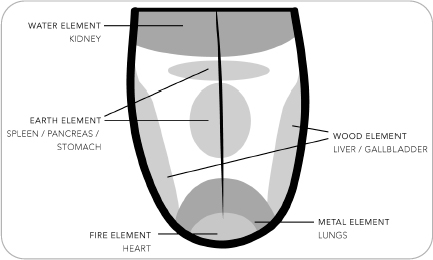
TONGUE WITH ELEMENT ZONES
A tongue that reflects optimal health should be pink and muscular without tooth marking or discoloration, and have very little coating. Look for color, shape, and coating changes in specific zones. When the color becomes deeper—going from pale to scarlet to purple—it indicates increasing heat in the body. Heat may mean inflammation, infection, or hyperactivity of the organ network. For example, the fire-element zone, which corresponds to the heart–small intestine network, and which includes both the emotional and the physical heart, is located at the tip of the tongue. Stress and anxiety will show up as red color and red dots on the tip of the tongue because the spirit resides in the heart network. Increasing heat signs mean hyperactivity in the heart network due to stress and tension.
When the tongue’s color becomes lighter—from pink to pale to paper white—it indicates cold, which can mean anemia, pathogenic cold factor, or low energy and function of the corresponding organ network. Many of my patients with low immune-system function, sometimes the result of chemotherapy or chronic fatigue syndrome, exhibit a pale tongue, indicating low energy and functional state.
The thickness and color of the coating, or a lack of coating, can indicate certain problems. When the coating turns from its normal thin and white to a thick, white, yellow, brown, or even black, infection or inflammation is deepening and the toxins from the infection are building up rapidly. Sometimes you may see a “geographic” tongue, meaning that it looks like some spots were scraped out from a particular area. This may mean depletion of essence in the organ network that corresponds to the peeled part of the tongue.
Teeth markings on the sides of the tongue usually indicate stagnation of the energy in the liver network, as the sides of the tongue correspond to the wood element. You may also notice a bluish-green or purplish hue or spots in that same wood-element zone. Dark spots may indicate more serious problems—on more than several occasions I’ve noticed purple spots in the wood zone in patients suffering from low energy, discomfort, distension around the lower ribs, and swelling in the abdomen. I immediately sent each of them to see a hepatologist (a liver specialist), who, unfortunately, confirmed either liver cancer or cirrhosis in seven out of ten cases.
The bandlike area across the tongue and just behind the tip is the metal-element zone, which corresponds to the respiratory and immune systems. When this area turns reddish, or when red pin-sized dots show up, it usually means a respiratory infection is on its way or is settling into the body. Paleness of the metal zone may reflect a weakened immune system. In rare fungal infections of the lungs, a brownish-black coating over the metal element zone may appear—this is the case with several of my patients who suffer from lesions in their lungs.
Gastroesophageal reflux disease (GERD), which keeps many people awake at night, may be indicated by redness and a yellowish coating in the center of the tongue. This area is the earth element zone, and it is related to the spleen-pancreas-stomach network, so problems of the digestive system most often show up here. Subtle changes in this area may indicate digestive problems that have not surfaced yet—observe this area and take prophylactic steps if necessary.
The back of the tongue reflects many of the body’s functions but it is predominantly the domain of the water element, or kidney-bladder network, which includes the hormonal system and sexual glands. The two large, elevated papilla on the back of the tongue are normal—they are part of the taste buds. What you should look for is color and coating. I can usually tell if a female patient is going to get a bladder infection when I see a thick yellow coating at the back-center of the tongue. I tell her to immediately start drinking eight to twelve glasses of water and take 5,000 milligrams of vitamin C a day, and drink cranberry juice or take its extract—a regimen that will typically prevent a bladder infection. Often those who don’t follow this preventive treatment call me a couple of days later reporting an infection.
EARS
If you look carefully, you’ll see that the ear is an image of an inverted fetus. The human ear provides a perfect map of the body. The head is at the lobe, the body curves around toward the top of the ear, and the spine is along the inner curve. The indentations or cavities inside represent the organ systems. The legs and feet correspond to the protruding upper cartilage of the ear. Because of this level of detail, the ear allows you to detect subtle abnormalities in your body’s functioning.
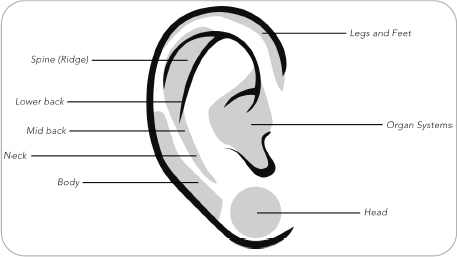
EAR WITH ELEMENT ZONES
The ear is unique in that it is involved in both health inspection as well as in treatment. In the practice of acupuncture, needles are inserted into zones on the ear that correspond to the diseased or imbalanced organ network or body parts. Similarly, you can perform acupressure by stimulating the acupoints on the ear with a rubber tip used to stimulate the gums, taping a magnetic pellet to the appropriate place, or pressing with your fingertip or fingernail. Simple ear acupressure can give immediate results. For instance, if you suffer from lower back pain, find the tender spot for the lower back by pressing along the cartilage that represents the spine. Stretch and pull apart the acupoint on the cartilage with the thumb and index fingers of both hands while bending and stretching your lower back—you may be surprised at how well this works.
Take note of any markings, lines, cysts or pimples, and discoloration on the ear map and then inspect the areas of the body that correspond to any areas of disturbance on the ear. For centuries health practitioners have observed that lines or wrinkles across the earlobe are signs of heart disease, or they may indicate that a person is prone to stroke, since the lobe corresponds to the head.
EYES
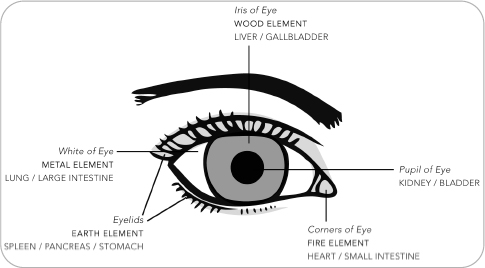
EYE WITH ELEMENT ZONES
The eyes are windows to your soul. By looking observantly into your own eyes, as well as into those of others, you can assess the clarity of the spirit of the person. You can also learn to detect early warning signs of disease by looking straight into your own eyes. Variation in the color of the iris and pupil from person to person is normal, but you want to look for changes from what is normal for you. For example, if the color of your iris were to go from blue to brown, that would signify potential problems with your liver.
The five element zones of the eyes are as follows: the corners of the eyes relate to the fire element, the whites of the eyes to the metal element, the iris to the wood element, the pupil to the water element, and the eyelids to the earth element. In Chinese medicine swollen or reddish eyelids, for example, indicate earth-element imbalance—digestive problems. Redness or irritation at the corners of the eyes may reflect stress to the heart—the fire element. When the whites of the eyes are irritated and red, it may mean trouble in the respiratory and pulmonary systems. If the whites are yellow, this may indicate jaundice, a sign of liver or gallbladder disorder, which requires immediate medical attention. Any changes within the iris may spell trouble for the liver, and dark circles under the eyes may mean hormonal imbalance, sinus allergies—or simply a need for sleep. A change in the size of the pupils is significant. It may indicate extreme adrenal exhaustion, shock or fright, or kidney disease.
HANDS
Your hands reveal a lot about you. The area right under the third finger to the middle of the palm is the fire element. The upper portion of the palm right under the index finger is the wood element. The fleshy area of the palm below the thumb is the metal element. The area below the fourth and fifth fingers, including the side of the hand in the upper two thirds of the palm, is the earth element. The fleshy inch-wide zone below the earth zone and above the wrist is the water element.
People suffering from respiratory problems such as asthma, bronchitis, and sinus infections almost always have redness, peeling, and itchiness in the metal-element zone. Digestive problems will be reflected in the earth zone, sometimes as swollen or sunken features. People with hepatitis or cirrhosis often have redness in the earth zone, as this heat or inflammation can transfer to the spleen-pancreas-stomach network. Purplish color or hardening of the skin in the fire-element zone can occur in people with heart disease. Hormonal imbalance or kidney-bladder network problems can be revealed through swelling or a purplish hue in the water zone.
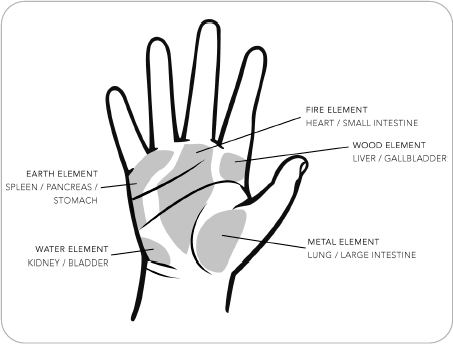
HANDS WITH ELEMENT ZONES
FINGERS
Sometimes you may feel pain or discomfort in a finger with no apparent reason. That is when it is important to know which organ system each finger corresponds to. The thumb corresponds to the metal element, the index finger the wood element, the middle finger the fire element, the ring finger the water element, and the pinky the earth element.
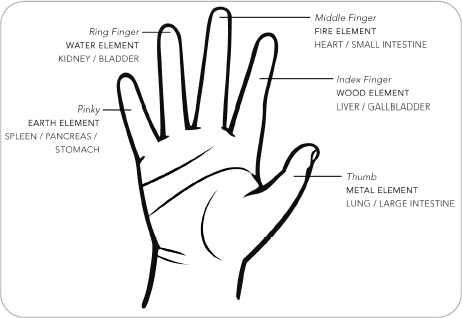
FINGERS WITH ELEMENT ZONES
When inspecting your fingers, look for changes to the texture and color of the skin, swelling or nodules forming on the joints, and veins or broken capillaries that suddenly appear. Also inspect the nails to note any lines, markings, or unusual changes. Dry skin patches, increasing redness, and veins and capillaries reflect heat or hyperactivity in the corresponding organ network. Swelling or nodules usually point to blockage of energy flow. Ridges and markings on nails typically indicate weakness and deficiency of the matching organ.
I often notice itchy eczema patches on the pinkies of patients with digestive-function disorders. And when a patient I’d known for several years suddenly developed nodules on his middle finger, even though he did not have any symptoms I sent him for a cardiac workup. The examination revealed a severe mitral valve defect.
Another patient came to me complaining of darkening and pigment spots on his hands, most noticeably on his ring fingers. Since the ring finger corresponds to the water element or kidney-bladder network (including the hormonal system), I sent him to an endocrinologist, who diagnosed him with Addison’s disease, a condition involving the adrenal gland—part of the hormonal system.
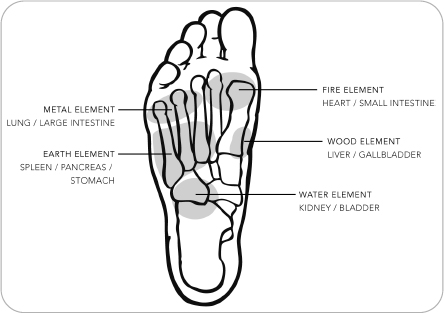
FOOT WITH ELEMENT ZONES
FEET
The map of the foot may be familiar to people who are familiar with of reflexology—the practice of stimulating zones on the feet, hands, and ears for beneficial effects on general health and specific parts of the body. The origin of reflexology is uncertain, but we do know that it has been part of the acupuncture health system for several millennia. Just as the body is a microcosm reflecting the inner workings of the natural law, various body parts are their own complete microcosm. I’ve discussed how to read your body’s functioning through outward signs on your face, tongue, and hands. The foot is no different, and it can aid you in your process of self-discovery.
The ball of the foot below the toes correlates to the fire and metal element, the arch the wood element, opposite the arch the earth element, and above the heel pad at the edge of the indentation the water element. By noticing changes in color, skin texture, and blood vessels, as well as tenderness from finger pressure, you can discover subtle functional changes within your body.
One patient complained to me about terrible pain on the inside arch and outside edge of her right foot. Countless X-rays and CT scans came up with nothing, and orthotic inserts did not offer any relief for her. I remembered that she had mentioned a family history of diabetes, so I suggested that she ought to rule out problems of the pancreas and digestive organs, since her pain spanned the earth-element zone. Tests confirmed the beginning stage of diabetes and probable peripheral neuropathy as a result.
This chapter represents the cumulative wisdom of five thousand years of Chinese medicine. With a little practice, you can begin to better understand your state of health and what imbalances may be affecting you. Once you identify an imbalance, take corrective measures so that it does not progress to a disease state. That is the fundamental principle of Wellness Medicine. The following chapters will reveal how to enhance the quality of your life with the five principles of self-healing—diet, herbs and supplements, exercise and acupressure, lifestyle and environment, and emotional and spiritual balance.
Please keep in mind that there are many ways in which your body alerts you to imbalances. As you learn this visual method, you’ll want to be able to confirm your findings from one body part with observations from others, such as the eyes, tongue, and nails. When all the signs and symptoms add up, you can be fairly certain of your discovery, at which point I suggest you either use Part 2 of this book to deal with minor imbalances naturally or consult with your health care practitioner.